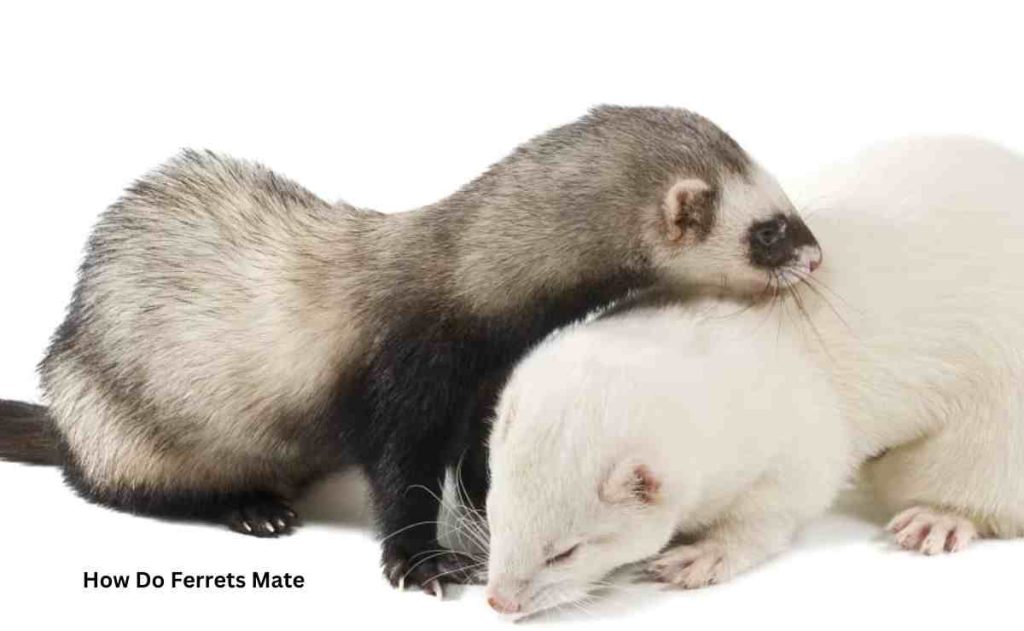Ferrets are funny creatures known for their long, slender bodies and bushy tails. These animals are popular pets all over the world, but not many people know how do ferrets mate? Breeding ferrets can be quite challenging as these animals have unique reproductive systems that differ from other domesticated animals.
So, if you’re a ferret owner or simply interested in learning more about these fascinating creatures, keep reading to find out everything you need to know about how ferrets mating.
From the mating process to gestation periods and litter sizes, we’ll explore every aspect of ferret reproduction in this article. We’ll also talk about the importance of responsible breeding practices and how to care for pregnant ferrets during their pregnancy.
How Do Ferrets Mate?

Ferrets typically mate during the spring and summer months. During this time, they are in their reproductive season, which is known as “rutting”. The female ferret will go into heat for a period of several days and she will be receptive to mating with a male.
The mating process begins when the male ferret follows the female around and makes loud vocalizations. He then mounts the female from behind and wraps his front legs around her body. This is known as “tieing” and can last anywhere from a few seconds to several minutes. After the tieing is complete, the pair will separate and the male ferret will move on to another female if there is one available.
Once mating has occurred, it usually takes about 40 days for the litter of kits (baby ferrets) to be born. The mother ferret will take care of her young until they are weaned at 8-10 weeks old.
How Often Do Ferrets Mate?
Ferrets typically mate once a year, usually in the spring. Males and females can breed as early as 5 months old, but it is recommended to wait until they are at least 8-10 months old before breeding.
The ferret mating season typically lasts for about 6 weeks, beginning in March or April. During this time, males will become more aggressive and active in search of a mate. The female will go into heat every 4 hours for 12-24 hours at a time during this period. After mating, the female will give birth to her litter of kits after a gestation period of approximately 42 days.
It is important to note that if you have both male and female ferrets living together, it is best to separate them when the female goes into heat to avoid unwanted mating and litter. Neutering or spaying your ferrets can also help prevent unwanted pregnancies.
At What Age Do Ferrets Become Ready for Mate?
Ferrets reach sexual maturity at around 6-8 months of age, although this can vary depending on the individual ferret. At this age, they will be ready to mate and start a family.
It is important to note that ferrets should not be allowed to breed until they are fully grown and in good health. Breeding too young can cause serious health problems for both the mother and her offspring. Additionally, it is important to make sure that both ferrets have been spayed or neutered before mating as this greatly reduces the risk of passing on any genetic diseases or illnesses.
Finally, it is also important to ensure that the environment is suitable for breeding ferrets. This includes making sure that there is enough space for them to run around and play as well as providing them with plenty of food and water. With the right care and attention, your ferrets will be able to have a successful mating experience.
How Many Babies Does A Ferret Give?
The average litter size for ferrets is between three and eight kits, with five being the most common. However, some ferrets can have litters of up to 15 kits. The gestation period for a ferret is approximately 42 days.
Ferrets are capable of breeding year-round, however, they typically breed in spring and summer when there is an abundance of food available for the mother and her litter. Female ferrets are induced ovulators which means that they will only become pregnant if they mate with a male ferret. If a female ferret does not mate with a male, she will not become pregnant.
It is important to note that if you plan on owning pet ferrets, it’s best to spay or neuter them as soon as possible due to their high reproductive rate and potential health problems associated with pregnancy.
How to Take Care of A Pregnant Ferret?
Taking care of a pregnant ferret requires a few special considerations.
- First, it is important to provide your pregnant ferret with plenty of food and water. Ferrets have high metabolisms, so they need more food and water than usual during pregnancy.
- A balanced diet of high-quality proteins, vitamins, minerals, and fats is essential for your ferret’s health. Additionally, it’s important to make sure your ferret has access to fresh water at all times.
- You should also provide extra bedding for your pregnant ferret. Pregnant ferrets need a comfortable place to rest and nest in order to prepare for the birth of their kits. Soft bedding such as blankets or towels can help keep her warm and cozy during her pregnancy.
- Finally, it’s important to pay close attention to any changes in your ferret’s behavior or health during her pregnancy.
Should You Neuter Your Ferret?
Yes, it is recommended to neuter your ferret. Neutering helps prevent reproductive cancers and other diseases that can occur in unaltered ferrets. Furthermore, neutered ferrets tend to be calmer and less aggressive, making them easier to handle.
Neutering should be done by a veterinarian experienced with ferrets. The procedure is typically performed when the ferret is between 4-6 months old and may require general anesthesia. Afterward, the ferret will need to be kept in a quiet place and monitored for signs of infection or other complications.
Overall, neutering can improve the quality of life for your pet and help keep him healthy for years to come. It’s important to talk to your veterinarian about the benefits and risks of this procedure before making a decision.
Conclusion
Ferrets have an interesting and unique way of mating that is both fascinating and important for their survival. From the male’s courtship behavior to the female’s reproductive cycle, there are several factors that contribute to successful mating.
Understanding how ferrets mate can also help pet owners properly care for their furry companions during the breeding season.
Whether you are a ferret enthusiast or just curious about animal behavior, learning about the mating habits of these adorable creatures is definitely worth exploring further. So, keep on discovering and appreciating the wonders of nature!
